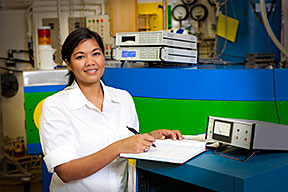- Number 402 |
- December 2, 2013
Moving fast: Neutron scattering work by ORNL's dela Cruz earns notice

Clarina dela Cruz.
Growing up in the Philippine province of Aklan on the island of Panay, Clarina dela Cruz was always encouraged to learn by her doctor mother and engineer father. At age 12, dela Cruz qualified to move to Manila to attend the Philippines Science High School—a special school that trains students at an early age to excel in college-level science, math and engineering courses.
Dela Cruz’s already established love for learning propelled her into the program and eventually into a position as a neutron scattering researcher at DOE’s High Flux Isotope Reactor at Oak Ridge National Laboratory.
“In high school, I saw more because the school really exposes you,” said dela Cruz. “You’re from a little school on a little island and now you’re in the city with all the resources in your hands. That really opened up the world for me and I decided when I was 13 that I was going to get my Ph.D.”
At 16, dela Cruz graduated high school and enrolled at the National Institute of Physics at the University of the Philippines.
After receiving her master’s, she moved to the United States to obtain her doctorate from the University of Houston in Texas. In 2007, she began working as a post-doc in ORNL’s neutron scattering program, which has capabilities that both intimidated and impressed her. She had never worked with neutrons before but knew how powerful they are. A mere three months after she joined ORNL, iron-based superconductors were emerging as a new hot topic and dela Cruz jumped on them.
“I work as fast as possible to learn new things,” dela Cruz said. “The science is moving you—it’s not going to wait.”
That kind of mindset pushes dela Cruz. As she learned the advanced technique of neutron scattering, she also worked to learn the field’s language and the people she worked with.
Her own biggest critic, dela Cruz didn’t think she was prepared to apply for an open position as an instrument scientist—that she wasn’t expert enough. Her mentors encouraged her to follow her science.
“They told me to believe in the science I was doing,” said dela Cruz. “Science is yours. No matter what post you hold, your responsibilities will change—but your science is yours and you take it with you.”
And straight out of her post-doc, dela Cruz was an instrument scientist.
“You can’t compare yourself with others in terms of achievement,” said dela Cruz. “If you’re surrounded by less-achieving people, you’ll set yourself below what you can do.”
Dela Cruz isn’t slowing down. Her work with correlated electron systems recently netted her the International Union of Pure and Applied Physics C10 Young Scientist Prize.
One of the correlated electron systems she is working on is called multiferroics. These materials have orders of ions, elastic response and magnetism that coexist and correlate, so if a magnetic field is applied to the material, not only will the magnetism change, but also the elasticity and ionic orders, allowing for greater control over the materials.
“They’re fantastic—we love that because we can put the material in many states and have many ways to control it using only one stimulus,” said dela Cruz. “Having control of a material is great because we can tune the materials and control functionality.”
Now, researchers are figuring out ways to use these studies and are finding that the materials are useful in spintronic applications, where current is controlled with charges and spins, and multi-memory state media.
Wherever her science leads, she’s on a path that began in the Philippines, where her mother and other family members still live.
“A role model guides you on how to be—and that’s my mom,” said dela Cruz. “I’ve been away from home since I was 12, but it’s never felt like it.” – by Dylan PlatzSubmitted by DOE's Oak Ridge National Laboratory
